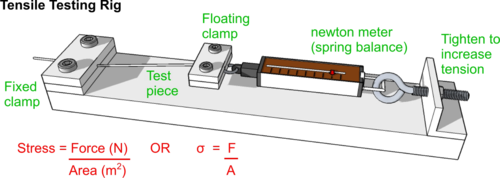Tensile Strength: Difference between revisions
From DT Online
mNo edit summary |
m (Corrected UTS definition) |
||
| Line 10: | Line 10: | ||
The load | The maximum load the sample can withstand before it breaks gives the [https://en.wikipedia.org/wiki/Ultimate_tensile_strength '''Ultimate Tensile Strength ''(U.T.S.)'''''] of the material. | ||
[[Category:Terminology]] | [[Category:Terminology]] | ||
Latest revision as of 12:54, 24 December 2015
Tensile Strength is a measure of how much a material can resist being stretched or pulled apart.
Data from which to calculate the Tensile Strength of material samples, can be obtained using the rig shown opposite. Such equipment is known as a Tensometer and industrial devices are used to measure how much a material sample stretches under stress to determine tensile properties of materials, such as its Tensile Strength.
Samples of thin line or wire may be gripped and stretched. The load applied is divided by the cross-sectional area of the test piece and this provides the value for the Tensile Stress being applied and any change in length divided by the original length will provide a value for Tensile Strain.
The maximum load the sample can withstand before it breaks gives the Ultimate Tensile Strength (U.T.S.) of the material.
